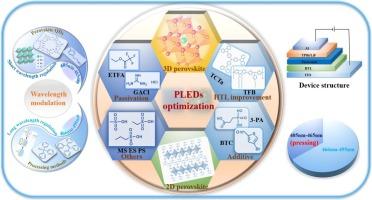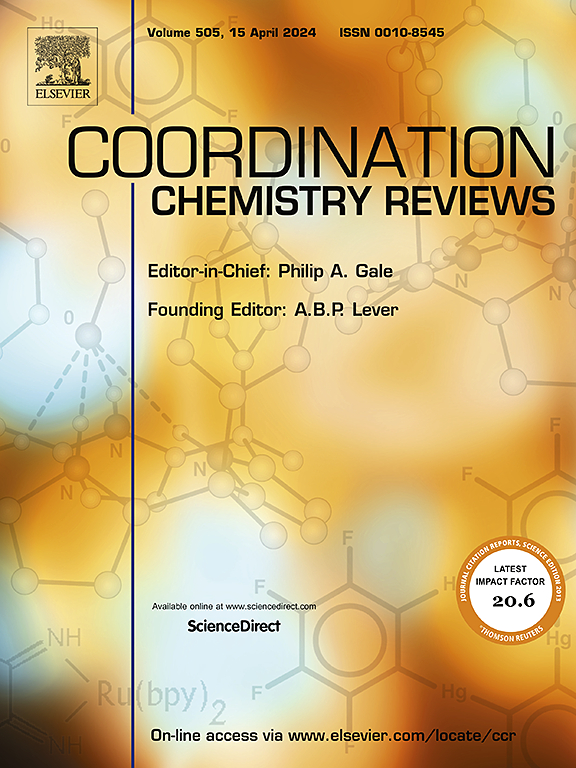蓝色钙钛矿led:提高性能的排放控制策略的全面审查
IF 23.5
1区 化学
Q1 CHEMISTRY, INORGANIC & NUCLEAR
引用次数: 0
摘要
蓝色发光二极管(led)在全彩显示中起着至关重要的作用,蓝色钙钛矿材料成为蓝色led的有前途的候选者。然而,蓝色钙钛矿led的发展仍然相对有限,特别是在颜色纯度或发射波长的精确调节方面。在本文中,我们根据国际照明委员会(CIE)定义的标准波长(465 nm)对蓝色发光区域进行了分类,将其分为两部分:短波长(405-465 nm)和长波长(466-495 nm)。然后,我们讨论了蓝色钙钛矿led在不同维度结构(3D和2D)上的最新进展,重点介绍了尺寸控制、离子掺杂和阴离子交换等策略,以在指定区域内微调发射波长。此外,我们总结了提高钙钛矿薄膜质量和减少非辐射复合的方法,包括改进空穴传输层和原位钝化技术。最后,我们概述了该领域当前面临的挑战,并提出了未来的展望,旨在激发对蓝色钙钛矿led研究的新见解,为该领域的活跃研究人员提供指导。本文章由计算机程序翻译,如有差异,请以英文原文为准。


Blue perovskite LEDs: A comprehensive review of emission control strategies for enhanced performance
Blue light-emitting diodes (LEDs) play a crucial role in full-color displays, with blue perovskite materials emerging as promising candidates for blue LEDs. However, the development of blue perovskite LEDs remains relatively limited, particularly regarding the precise regulation of color purity, or emission wavelength. In this review, we categorize the blue light-emitting region based on the standard wavelength (465 nm) defined by the Commission Internationale de l'Eclairage (CIE), dividing it into two segments: short wavelengths (405–465 nm) and long wavelengths (466–495 nm). We then discuss the latest advancements in blue perovskite LEDs across different dimensional structures (3D and 2D), highlighting strategies such as size control, ion doping, and anion exchange to fine-tune the emission wavelength within the specified regions. Furthermore, we summarize methods to enhance the quality of perovskite films and minimize non-radiative recombination, including improvements to the hole transport layer and in-situ passivation techniques. Finally, we outline the current challenges in the field and present future perspectives aimed at inspiring new insights into blue perovskite LEDs research, providing guidance for active researchers in this area.
求助全文
通过发布文献求助,成功后即可免费获取论文全文。
去求助
来源期刊

Coordination Chemistry Reviews
化学-无机化学与核化学
CiteScore
34.30
自引率
5.30%
发文量
457
审稿时长
54 days
期刊介绍:
Coordination Chemistry Reviews offers rapid publication of review articles on current and significant topics in coordination chemistry, encompassing organometallic, supramolecular, theoretical, and bioinorganic chemistry. It also covers catalysis, materials chemistry, and metal-organic frameworks from a coordination chemistry perspective. Reviews summarize recent developments or discuss specific techniques, welcoming contributions from both established and emerging researchers.
The journal releases special issues on timely subjects, including those featuring contributions from specific regions or conferences. Occasional full-length book articles are also featured. Additionally, special volumes cover annual reviews of main group chemistry, transition metal group chemistry, and organometallic chemistry. These comprehensive reviews are vital resources for those engaged in coordination chemistry, further establishing Coordination Chemistry Reviews as a hub for insightful surveys in inorganic and physical inorganic chemistry.
 求助内容:
求助内容: 应助结果提醒方式:
应助结果提醒方式:


